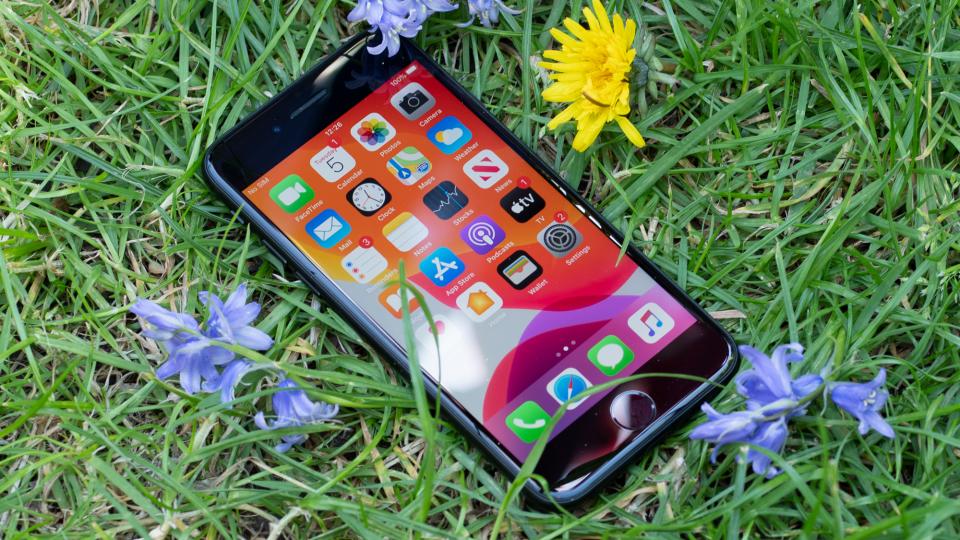
The iPhone SE gets an upgrade at last and it’s now as powerful as the iPhone 11
Pros Compact and lightweightImpressive single cameraAs fast as an iPhone 11Cons Small screenOnly one cameraPoor battery life
The iPhone SE 2020 has been a long time coming. So long, in fact, that I’d given up on it ever seeing the light of day. But here it is in all its tiny-screened, easily pocketable glory and you have to wonder why Apple didn’t do it sooner.
The answer, of course, is that it would prefer its customers to spend more on an iPhone 11, iPhone 11 Pro or iPhone 11 Pro Max than the lower asking price for the iPhone SE. But with iPhone sales declining recently and threatening to be engulfed by Android rivals, Apple needs to encourage more people to buy iPhones, and tie them into the iOS ecosystem.
Apple iPhone SE 2020 review: What you need to know
The iPhone SE 2020 comes along at the perfect time in more than one way and it delivers a straightforward offering. It takes the chipset from the latest iPhones and wraps it up in a smaller, simpler, cheaper package.
By modern standards, the iPhone SE is a bit dated. It has a tiny 4.7in screen, which doesn’t reach right to the edges of the phone’s body, and has only one camera on the rear, which lacks some of the advanced features of the more expensive models. There’s no Face ID facial recognition login either – only Touch ID.
Yet, the iPhone SE 2020 can run apps and games almost as fast as the £1,200 iPhone 11 Pro Max thanks to its modern, super-powerful Apple A13 Bionic chipset and it runs iOS 13 out of the box.
Buy the iPhone SE from John Lewis
Apple iPhone SE 2020 review: Price and competition
The iPhone SE, much like its predecessor, is now the cheapest iPhone in Apple’s range. It costs £419 for the model with 64GB of storage, £469 for the 128GB model and £569 for 256GB and contract prices start at around £30 per month with an up-front fee of £30 (from Three).
The next phone up the ladder is the Apple iPhone XR, which costs £629 for the 64GB model and £729 for 128GB. It has a bigger screen and looks more modern than the SE but it isn’t nearly as powerful as it uses the older A12 Bionic chipset.
As for the Android competition, you’re looking at the Google Pixel 3a (£329) and Google Pixel 3a XL (£399) as the main contenders for your money and, perhaps, the Samsung Galaxy A70. Even the smaller Pixel 3a has a bigger screen than the iPhone SE at 5.6in, although it’s nowhere near as powerful.
Here’s a list of those alternatives and where to buy them:
- Google Pixel 3a: £329 from Amazon
- Google Pixel 3a XL: £399 from Amazon
- Samsung Galaxy A70: £341 from Amazon
- Apple iPhone XR: £629 from John Lewis

Apple iPhone SE review: Design
If you want a reference point for the design of the iPhone SE 2020 then look no further than the iPhone 8. Launched at the same time as the iPhone X back in 2017, the iPhone 8 remained on Apple’s books until the reappearance of the iPhone SE this year.
Indeed, the iPhone SE 2020 essentially duplicates the physical appearance of the iPhone 8 to the millimetre and gram. It’s 138mm tall, 67mm wide and 7.3mm thick.
It weighs 138g with glass panels sandwiching an aluminium frame and it’s available in black, white and “Product Red” colours (a portion of funds raised from the Product Red phone contribute to the Global Fund to combat COVID-19).
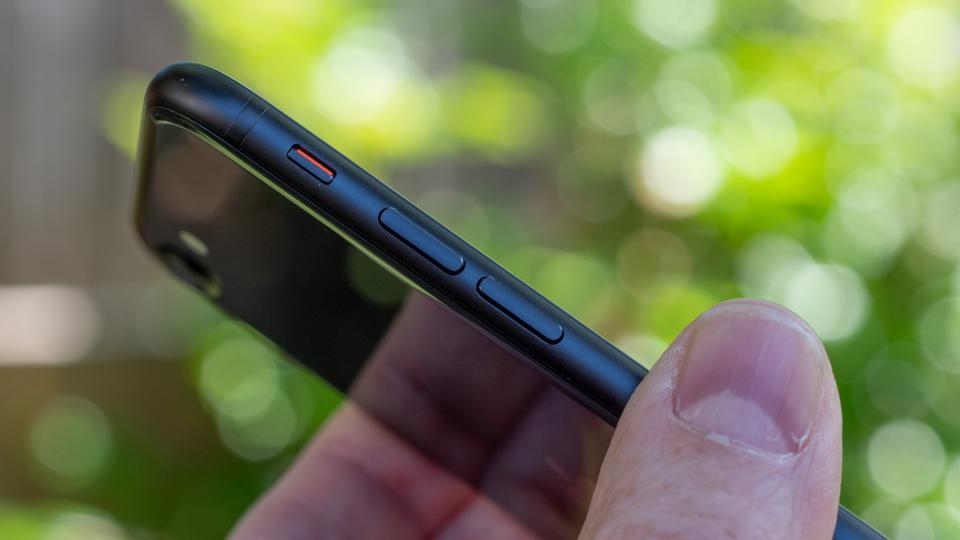
All the various buttons and external features are in precisely the same place as the iPhone 8, too. The single camera sits at the rear in the top left corner, the volume buttons and do not disturb switch are on the left edge and the power button is on the right. The Lightning connector on the bottom is flanked by a pair of speaker grilles and the Touch ID button on the front is haptic instead of mechanical.

Apple iPhone SE 2020 review: Display
When you’ve spent the past two years looking at phones with edge-to-edge displays, a handset with honest to goodness bezels at the top and bottom comes as something of a shock. No matter how much I try to love the smaller size (it is nice to operate a phone with one hand for once) there’s no denying that a bigger screen is so much better for watching TV and movies and playing games on, and that dinky screen does make it more fiddly to type out emails and social media messages.
Still, what’s here is pretty good. It’s an IPS panel measuring 4.7in across the diagonal and it has a Retina-class resolution of 1,334 x 750 with a pixel density of 336ppi. That, incidentally, is the same as the original iPhone SE (4in screen) and the iPhone XR (6.1in screen).

It’s sharp enough, then, and it’s also pretty good from a technical standpoint. I measured it with the office calibrator and found that peak brightness settled at 571cd/m2 and contrast at 1,427:1 – both solid figures. Colour performance is as good as ever from Apple, with sRGB coverage hitting 95.5% and the average Delta E at a healthy low of 0.96 (lower is better).
Apple iPhone SE review: Performance
With the same Apple A13 Bionic chip under the hood as its more expensive siblings (although half as much RAM at 3GB), you’d expect performance to keep up a bit better, and that certainly appears to be the case.
It’s far, far quicker than the old iPhone SE. What’s most eye-opening, however, is how much faster this phone is than Android rivals at the same price – namely, the Google Pixel 3a and Pixel 3a XL:
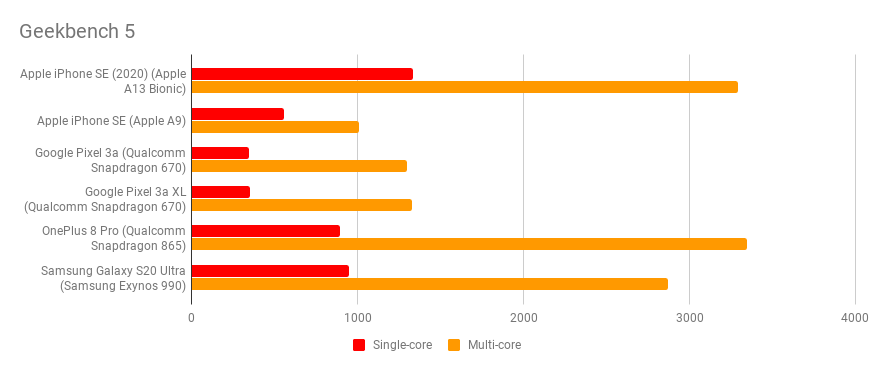
Alas, our normal graphics benchmark – GFXBench – isn’t working on iOS right now, so I’ve substituted the iPhone 11 in the graph below, which should give you a close idea of how the iPhone SE 2020 will perform. Indeed, I’d expect the numbers to closely match those of the iPhone 11:
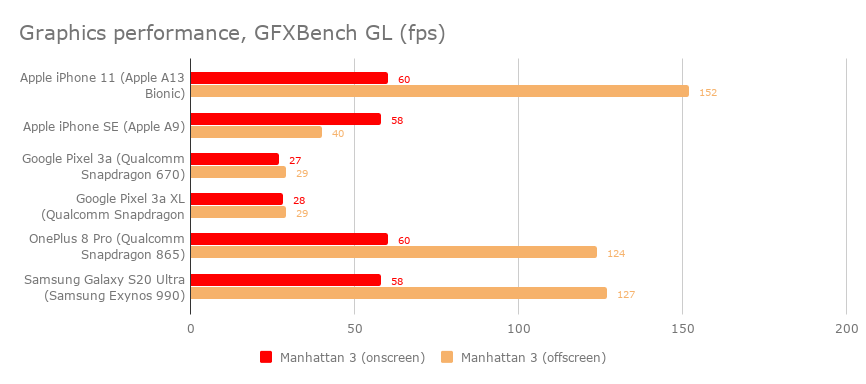
In short, the iPhone SE (2020) is easily the most powerful hardware in a phone costing less than £500 today. It’s also worth noting that it’s more than a match in raw performance terms for the latest Qualcomm Snapdragon 865 phones such as the OnePlus 8 and 8 Pro.
Sadly, there’s one crucial area where the iPhone SE 2020 can’t match up with its competitors and that’s battery life. With the same tiny 1,821mAh power pack as the original iPhone 8, stamina suffers badly. Indeed, the SE only lasted 11hrs 35mins in our fairly undemanding video rundown test, which is better than the iPhone 8 but worse than the original iPhone SE.
Apple has added fast 18W charging this time around, which mitigates this somewhat and gets the phone up to 50% in 30 minutes but, when most modern flagships are lasting 20 hours plus in this test, it is impossible not to be disappointed by this result.

Apple iPhone SE 2020 review: Camera
It’s a bit of a relief for me, at this point, to only have to test and summarise two cameras: one 7-megapixel f/2.2 selfie camera and a 12-megapixel f/1.8 main camera at the rear. The specifications are the same, you won’t be surprised to discover, as the iPhone 8, although it’s important to note that with the power of the A13 Bionic behind it, image quality is much improved.
Interestingly, there’s no Deep Fusion low-light mode or night mode, but the photos I’ve grabbed with the iPhone SE 2020 have been good across the board, with Apple’s portrait mode bringing out the best of the 12-megapixel sensor, providing all the same lighting effects as you get in the pricier iPhones.
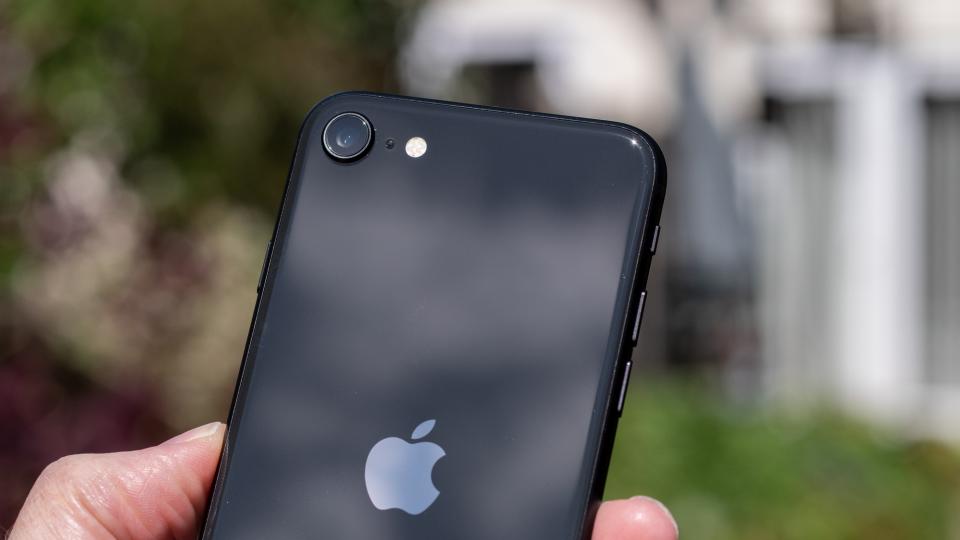
You can see in the shots below, captured with the main camera, that it can’t quite match the iPhone 11 Pro Max’s incredibly sharp images, but it’s more than a match for the Realme 6, which is a budget phone that outperforms its low £220 price tag. (I’d like to be able to compare with the Pixel 3a at this point but with lockdown restrictions in place I don’t currently have access to that phone for comparison purposes.)
I’ll start with portrait images, where the iPhone SE performs well, but where it’s easiest to pick out the problems. In the image below, for instance, it’s easy to see that the skin textures are softer and the hairs not as sharp. Otherwise, though, it’s a very good image and not a world away from the iPhone 11 Pro Max:
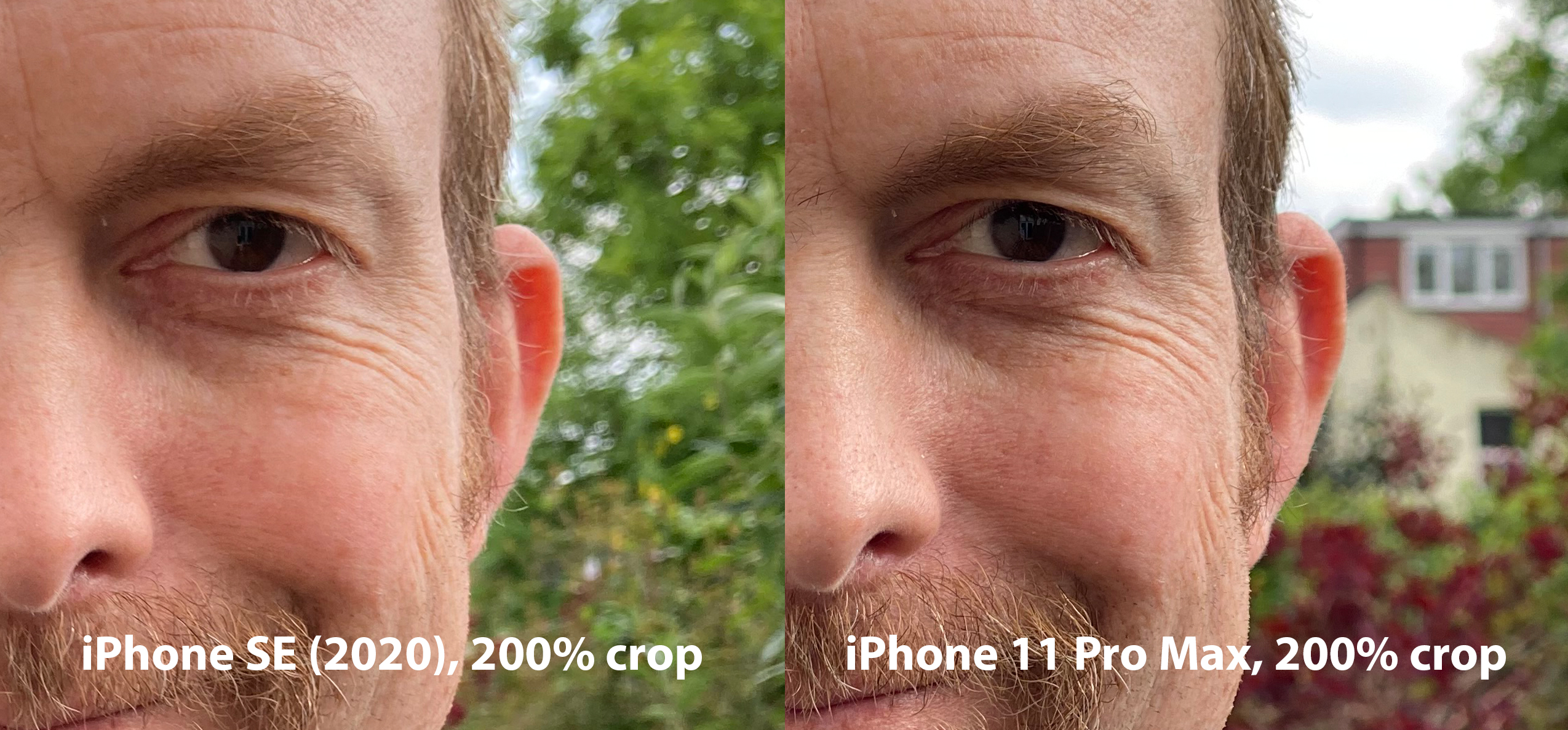
It’s slightly better than the Realme 6 in this test with a less artificial-looking image but details do still look a little on the soft side:
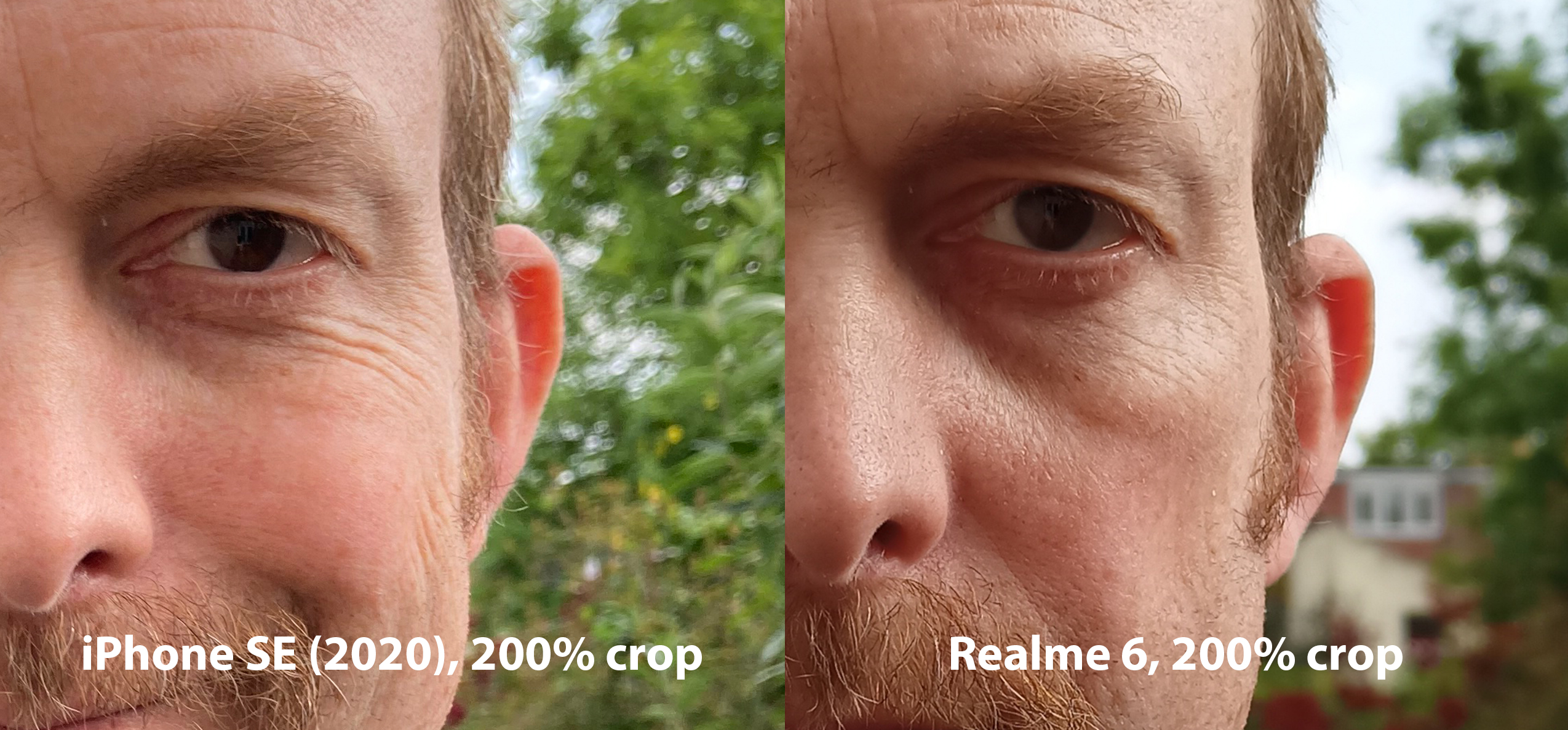
It’s a similar story in the images below. There’s a good amount of crisp detail in the SE shot, with the iPhone 11 Pro Max again producing crisper details and a richer palette of colours:
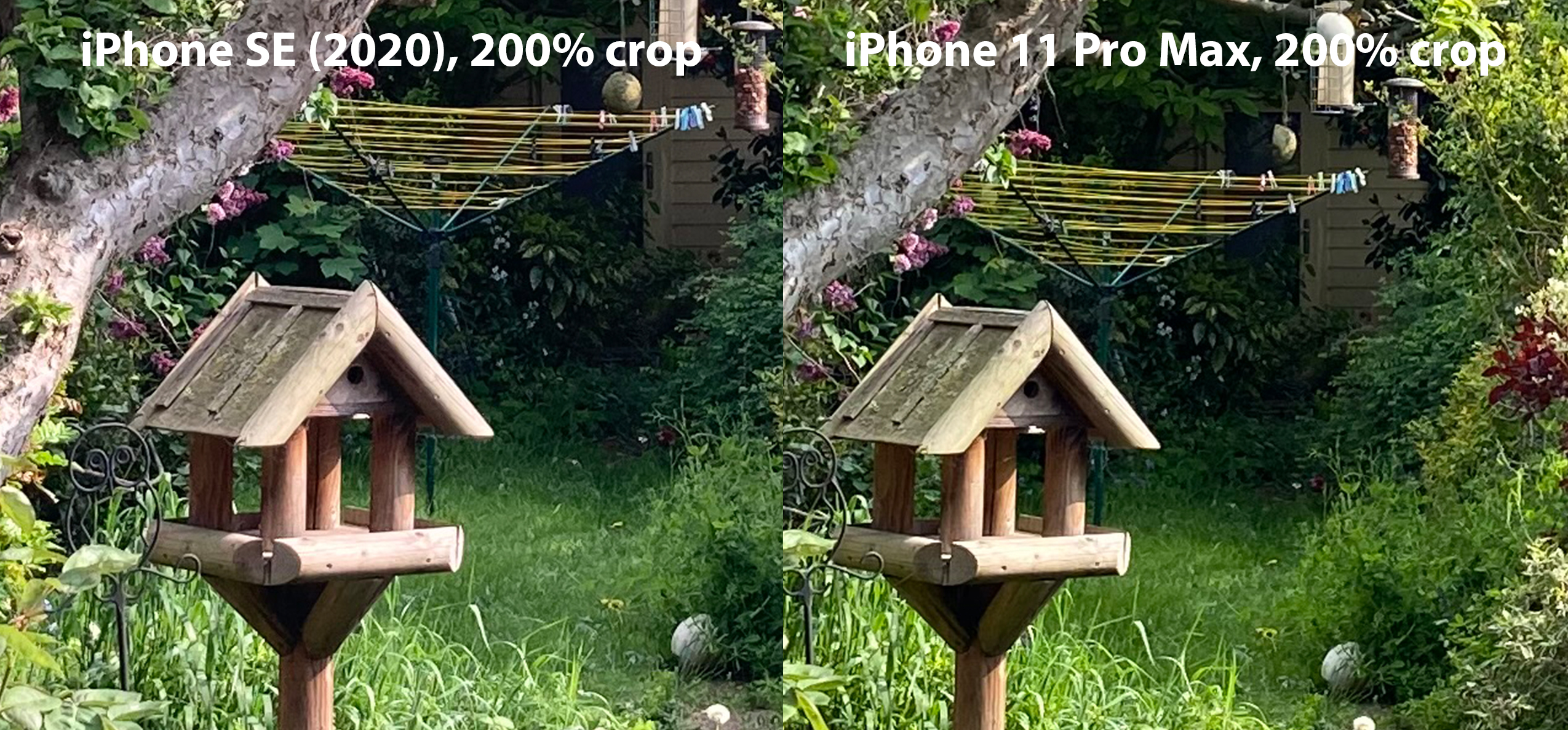
It’s better than the Realme 6 again here, with more considered use of image compression and more natural colours:
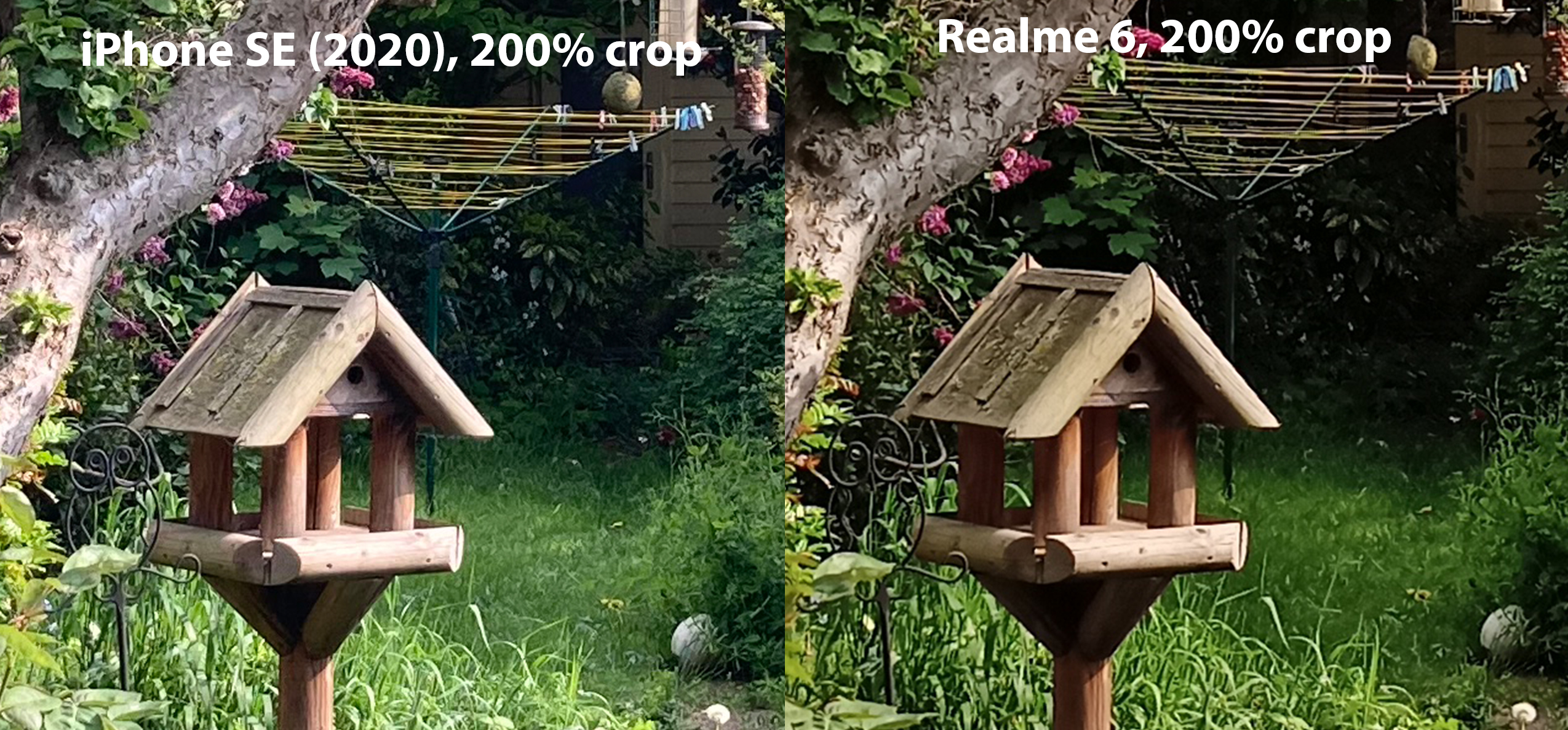
Surprisingly, in low light, the iPhone SE 2020 holds its own against the iPhone 11 Pro Max. Although there’s clearly more noise in the SE’s image, it isn’t overly distracting and colours are still nice and neutral. It is a somewhat darker exposure, which rescues it from looking too nasty:
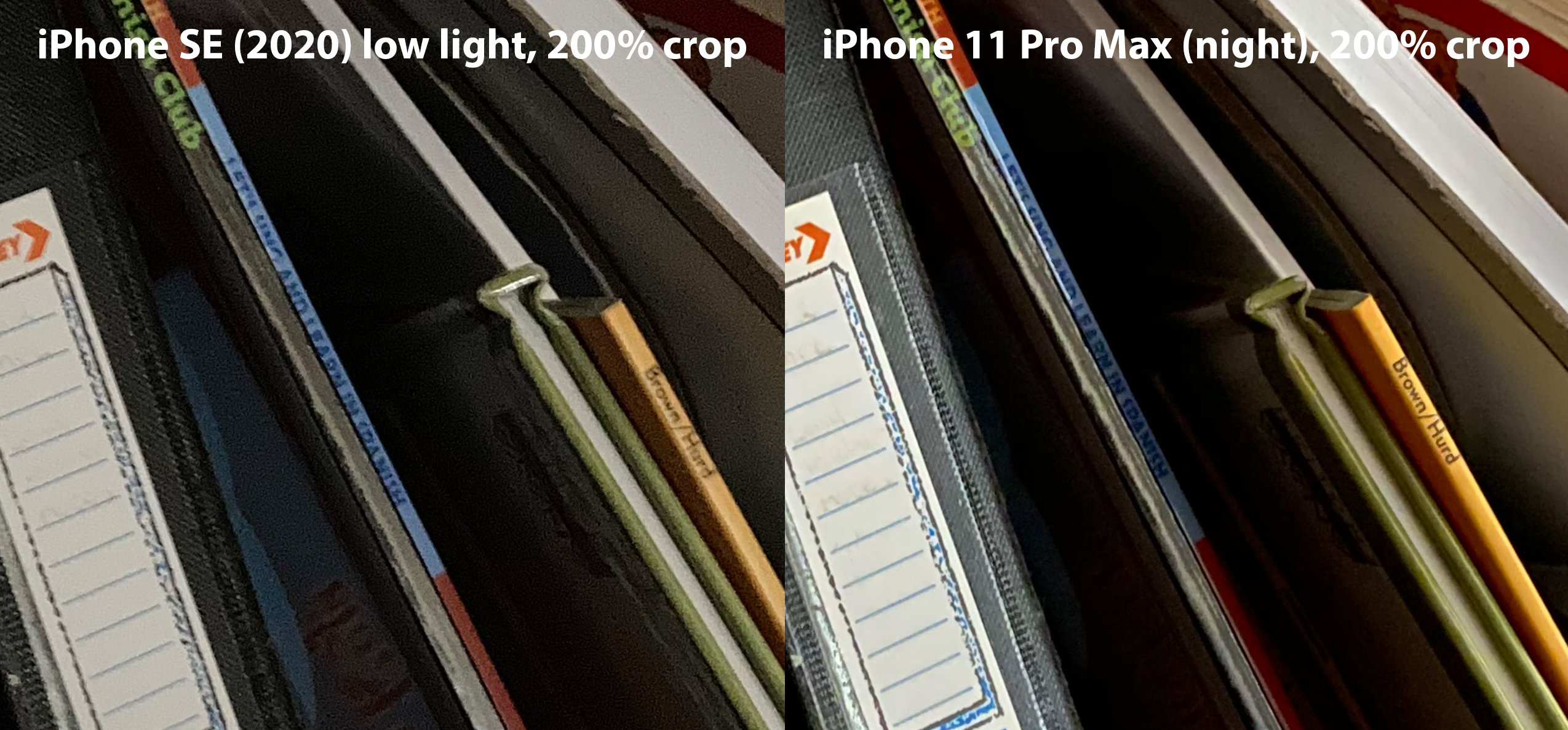
Here’s the same, but shot on the cheaper Realme 6:
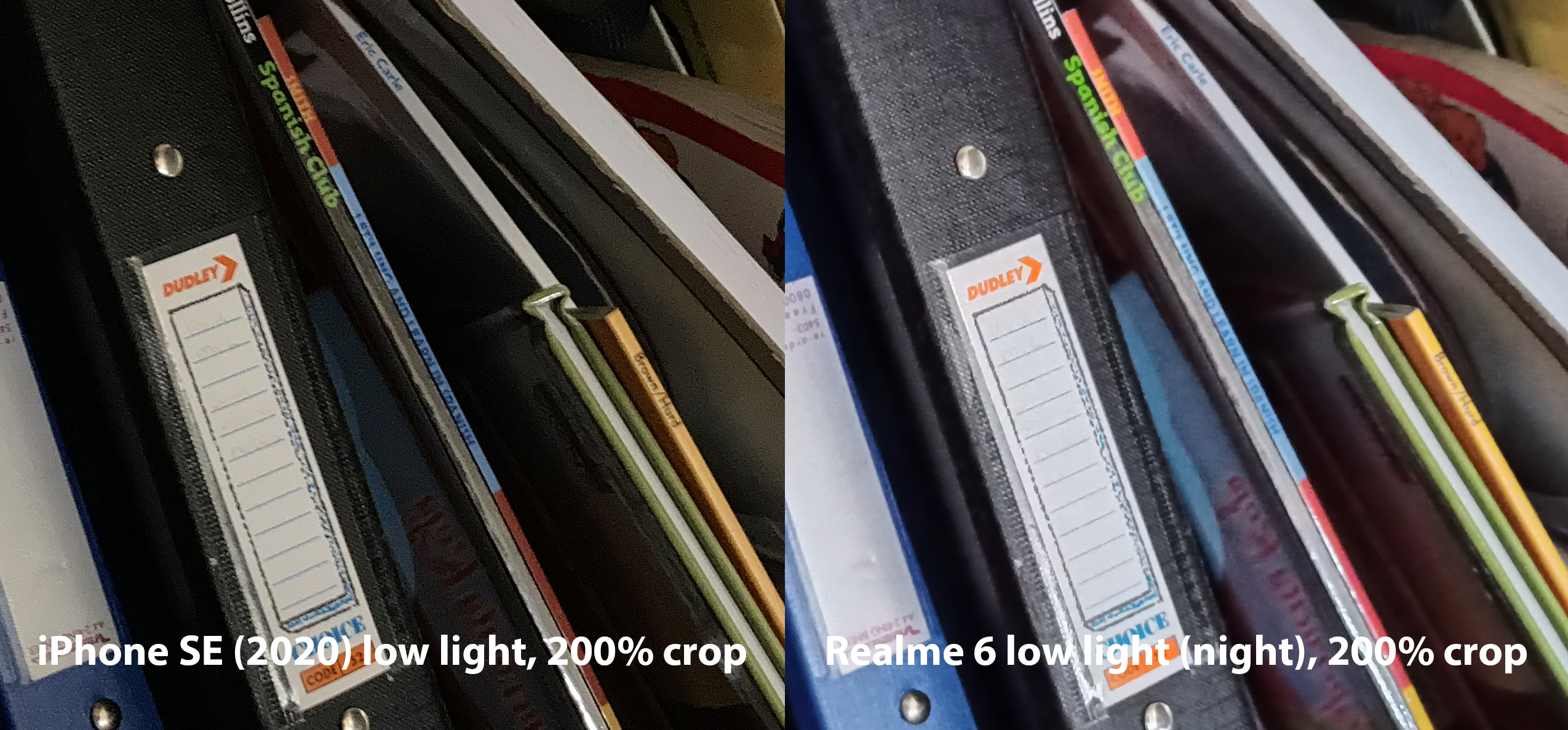
The Realme captures a brighter image but it’s somewhat over-processed and colours are a little unnatural.
All in all, the iPhone SE 2020’s main camera performs remarkably well. It isn’t as good as the iPhone 11/Pro/Pro Max’s main camera but you’d expect that. What’s surprising is how well it holds up across the board, producing images and portraits that generally look great in good light and bad.
Perhaps more impressive than this, however, is how good the iPhone SE 2020’s video capture is. This is where the phone’s A13 Bionic chip really comes into play, enabling Smart HDR to keep exposures nice and even, and able to apply image stabilisation to 4K footage recorded at 60fps.

Video quality is simply sumptuous, too, with plenty of detail, stabilisation that’s smooth without looking overly artificial and a smooth frame rate that ensures your home movies will look great in most situations.
In short, there is nothing else that can compete with the iPhone SE 2020’s video-capture capabilities at this price. All told, despite the lack of ultra-wide-angle and zoom options, you’re getting a very good quality camera here.
Buy the iPhone SE from John Lewis
Apple iPhone SE (2020) review: Verdict
On the face of it, the iPhone SE is little more than a warmed up iPhone 8 – a hodgepodge of parts old and new that shouldn’t really work together. It has a tiny display and it looks frankly old-fashioned with those comparatively enormous bezels. And, yet, there are many reasons you might consider it.
It has a great camera and amazing performance, it’s smaller and lighter than most phones released today and, let’s not forget, it’s the cheapest iPhone by quite a distance. The fly in the ointment here is battery life which, not to put too fine a point on it, is poor. That makes it impossible to award the iPhone SE (2020) the full five stars, unfortunately.
However, if you only have £419 to spend and you just don’t get on with bigger phones, or you simply must own an Apple handset, the iPhone SE (2020) is still well worth considering. It may be the cheapest iPhone but it’s still mightily impressive.
Apple iPhone SE 2020 specifications |
|
| Processor | Hexa-core Apple A13 Bionic (2 x 2.65GHz, 4 x 1.8GHz) |
| RAM | 3GB |
| Screen size | 4.7in |
| Screen resolution | 750 x 1,334 |
| Pixel density | 326ppi |
| Screen type | IPS |
| Front camera | 7MP, f/2.2 |
| Rear camera | 12MP, f/1.8 |
| Flash | Quad-LED |
| Dust and water resistance | IP67 |
| 3.5mm headphone jack | No |
| Wireless charging | Yes |
| USB connection type | Lightning |
| Storage options | 64GB; 128GB; 256GB |
| Memory card slot (supplied) | No |
| Wi-Fi | 802.11ax (802.11AX) |
| Bluetooth | 5, LE |
| NFC | Yes (payments only) |
| Cellular data | 4G (1024Mbits/sec DL; 150Mbits/sec UL) |
| Dual SIM | Yes (via eSIM) |
| Dimensions (WDH) | 67 x 138 x 7.3mm |
| Weight | 148g |
| Operating system | iOS 13 |
| Battery size | 1,821mAh |
